

In the first step all the rules of the chess game are introduced. Furthermore, much attention is paid to developing of the basic skills, necessary to play chess.
Comparing with other books for beginners the step-by-step method introduces an unique sequence of the teaching material. Learning how to mate is postponed as long as possible. This sounds astonishing and even incredible but up till now, practice has shown that this approach works perfectly. Children learn to play chess very well, for sure if they get enough time in between to play and practice.
The 'first Step' consists of a manual for the trainer and workbooks for the students: Step 1, Step 1 extra, Step 1 plus and Step 1 mix. There are special books available for children from 6 till about 9 years old: the Stepping stones.
• Manual for chess trainers Step 1
Download excerpts of each book: Samples
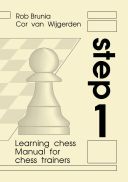
The manual is a great support for the trainer, even if he is an experienced one. Ready made lessons, hints how to use the workbooks, how to give assistance, and so on. Almost everything is to be found there.
Contents:
Introductions:
The first Step is divided in 15 lessons.
1: Board and pieces
2: Moves of the pieces
3: Attacking and capturing
4: The pawn
5: Defending
6: Check and getting out of check
7: Mate (1)
8: Mate (2)
9: Castling
10: Profitable exchange
11: Twofold attack
12: Draw
13: Mating with the queen
14: Taking 'en passant'
15: The notation
Step 1 plus
The themes in the Plus section concentrate very much on the improving of board vision. The material is to a great extent familiar, though there is an important extra: students are asked to choose between two different options. That is true for the lessons "Winning material", "Defending" (defending is also dealt with in two other lessons) and "Board vision". We come up against the spatial aspect, which is still a difficult topic for this Step, in the lessons on mate and draws. We go into both of these concepts in more depth and we set different types of exercise. When a concept is difficult, and "mate" is certainly that, it helps to do a lot of varied practice. In Step 1 the student really has to think, otherwise he won't succeed. He really has to get into things. We deal with all the themes in eight Plus lessons. Some of these can be short. The main thing is that the students are able to solve the exercises correctly. For that reason we do not recommend to skip the instruction.
1: Winning material
2: Defending
3: Mate
4: Board vision
5: Defending against mate
6: Draws
7: Creating mate
8: The passed pawn
Stepping stones
In a long chapter we pay attention to teaching young children and how to deal with the 2 Stepping stones. The workbooks "Stepping stones 1 and 2" are designed in the first place for children between the ages of six and nine.
The lessons from Step 1 at the start of the introduction are our starting point. In this chapter, suggestions are made for every "lesson" as to how to work with different age groups. The trainer or parent must decide for himself or herself which is the best way to proceed for the group or for any individual.
Use the drawings in the work books to help you with your explanations. In many cases they make it easier to understand a concept.
A "lesson" (= chapter) must be considered as a whole. But of course a lesson should not be rattled through in a single lesson (= hour's teaching)!

In addition to the exercises there are reminders in the workbook. These are short recapitulations of the lessons in the manual for the pupils.
There are 13 reminders.
On the remaining 42 pages there are always 12 positions a page. That means a total number of 42x12-18 (the drawings) = 486 positions.
Have a try? Mate in one
The issues of the exercises are the same as in the manual.
See Manual for chess trainers.
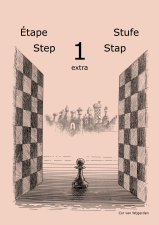
Read more about the Extra books in info.
The extra workbook is full of exercises. The reminder can be downloaded Step 1 extra .
The first 44 pages of the workbook contain the assignments with the same subjects as in the
basic workbook of Step 1. These are not only useful as extra exercise but also as a repetition.
The last 12 pages are mixed tasks without a theme indication. That means that there is no hint as to the theme of the exercise, with the result that they are more like a real game. Solving exercises of this sort is difficult for those on Step 1. Fortunately the subjects of the exercises are restricted to themes dealt with in Step 1: winning material, delivering mate in one and defending. That was just about everything. For every task the student should go through and tick off the three questions on this list:
- Can I win material?
- Can I deliver mate?
- Is one of my pieces in danger?
You will find the answers to the exercises on the website: download
A page with mixed exercises: Mix: D
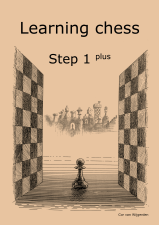
Read more about the plus books in general in the info.
Why is Workbook Step 1 plus important?
Almost all the students are not yet able to play chess well enough even after finishing the workbook accompanying Step 1. In every game pieces are still being given away and pieces which have been left en prise by the opponent are not always being taken. They do not yet have a sufficiently good overview of what is happening on the board, i.e. they do not yet see all the possible attacking and defensive options. We must tackle this vision as our top priority, or else it will remain a serious weakness for longer than necessary. We should not deal with new material before the children have mastered the basics to a great enough degree. Watch carefully to be sure that they apply in their own games what they have learnt from the lessons and the exercises. Should a child not spot immediately that one of the pieces is hanging, then it makes little sense to want to teach him to look for the double attack (Step 2) in his own games. If, during a game, someone is obliged to look carefully to see if a piece is en prise, then that person will certainly not spot that on the next move two pieces will be in danger! The best method for the improvement of children's board vision is to let them play games. It is helpful to remember that every child will require a different amount of time to master every phase (as defined in the introduction in the manual "How children learn to play chess"). One child may need to play 300 games, another one perhaps 1000. Of course, solving exercises also develops this overview of the board.
The contents of the Workbook Step 1 plus:
More or less new topics:
Elaborating the already introduced material:
You can find plus lessons in the manual of Step 1.
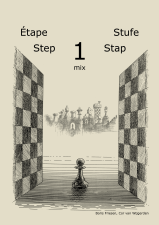
Read more about the mix books in info.
In the mix workbook are 61 pages with exercises, which means as many as 61x12=732-9 (drawings e.o) = 723 puzzles.
The theme's are known from Step 1 and Step 1 plus. A workbook containing exercises with one ‘simple’ assignment: play the best move. Just like in a real game, you do not know whether you can win or whether you have to defend. First, look at what’s going on? Can you give mate? Is winning material possible? Is there a piece in danger? In short, all kinds of stuff.
Two kinds of puzzles are different: on each page you will find a multiple choice question and a position with a line below the diagram. Only on the last 8 pages there is an indication of the theme: 2 pages with mate and 2 pages with defending. Why an indication of the theme? The puzzles are really a challenge.
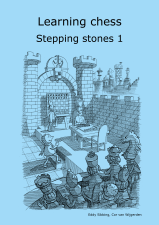
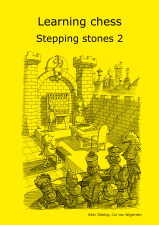
Workbook Step 1 is often used with very young children. It is possible but not ideal. It is not surprising since the step-by-step method was developed in 1987 for children from the age of 9 on.
The tendency is that children learn to play chess younger and younger. For children at the age of 5/6 years old approximately, two special workbooks appeared where the exercises are adapted to this age group.
Naturally, the contents of these workbooks overlap partially the 'usual' Step 1. Part one of Stepping stones corresponds to lesson 1 up till 6 in the manual, part two begins with mate.
(See Manual for chess trainers)
What are the differences with the usual workbook Step 1?
Instructors (frequently parents as well) have to rely on the Manual of Step 1. A chapter is devoted on teaching chess to very young children. Furthermore, it will contain information how to deal with each page of the workbook and what are the expected difficulties.
The answers of both workbooks can be downloaded.